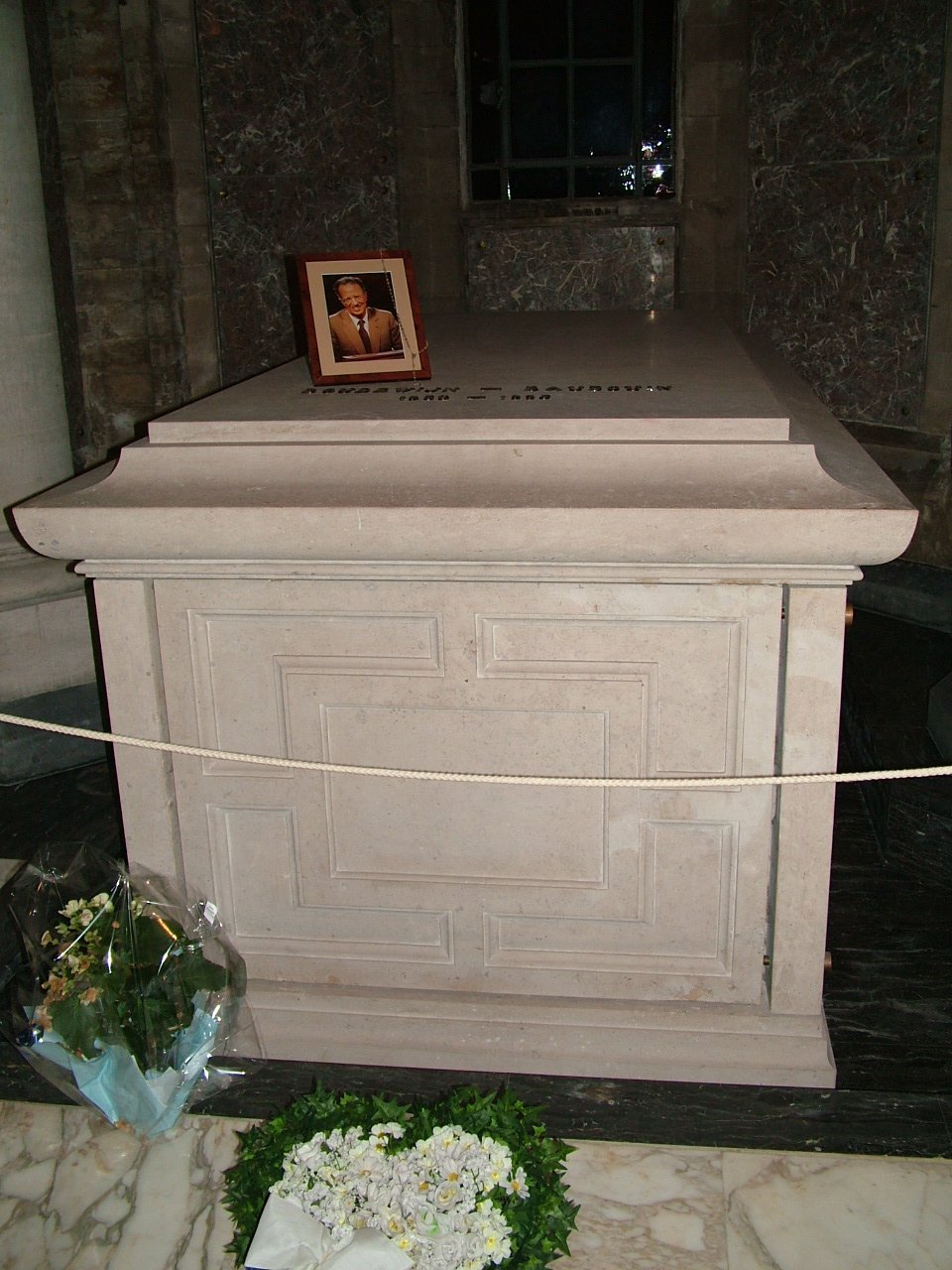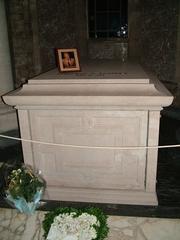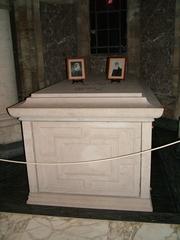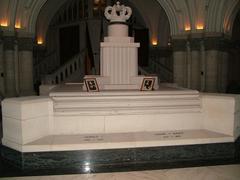
Royal Crypt Visiting Hours: Tickets and Complete Guide to Historical Sites in Brussels
Date: 03/07/2025
Introduction
Beneath the neo-Gothic Church of Our Lady of Laeken in Brussels lies the Royal Crypt, a profound monument dedicated to Belgium’s royal legacy. Commissioned by King Leopold I in the 19th century to honor Queen Louise-Marie, this crypt is the final resting place for the majority of Belgian monarchs and their consorts since the country’s independence in 1830. Visitors are invited to discover Belgium’s dynastic history through an impressive setting of marble sarcophagi, vaulted ceilings, and symbolic art.
This guide provides all the essential information—visiting hours, ticket details, accessibility, transportation, and nearby attractions—so you can plan a meaningful and rewarding visit. Make sure to consult official resources for the latest updates: Church of Our Lady of Laeken website, visit.brussels, History of Royal Women, and Unofficial Royalty.
Contents
- Introduction: Why Visit the Royal Crypt in Brussels
- History and Construction of the Royal Crypt
- The Royal Family and the Crypt’s Purpose
- Visiting the Royal Crypt: Hours, Tickets, and Accessibility
- Architectural and Artistic Features
- The Crypt’s Role in National Identity
- Nearby Attractions
- Frequently Asked Questions
- Visual and Media Recommendations
- Conclusion and Visit Tips
History and Construction of the Royal Crypt
The Royal Crypt is situated beneath the Church of Our Lady of Laeken (Église Notre-Dame de Laeken), a key neo-Gothic church in Brussels’ Laeken district. Construction began in 1854, following King Leopold I’s commission in memory of Queen Louise-Marie. The church’s design, led by Joseph Poelaert with later contributions by Friedrich von Schmidt, was completed in 1872 (History of Royal Women; Unofficial Royalty).
The crypt, directly beneath the main altar, was conceived as a royal mausoleum, symbolizing both the continuity of the Belgian monarchy and the nation’s unity. The church’s neo-Gothic style, with soaring arches and intricate tracery, enhances the solemn dignity of the crypt below.
The Royal Family and the Crypt’s Purpose
The Royal Crypt serves as the principal burial site for Belgian monarchs and their consorts. Beginning with Queen Louise-Marie, the mausoleum houses the tombs of:
- King Leopold I and Queen Louise-Marie
- King Leopold II and Queen Marie-Henriette
- King Albert I and Queen Elisabeth
- King Leopold III, Queen Astrid, and Princess Lilian
- King Baudouin and Queen Fabiola
- Prince Charles, Count of Flanders
- Empress Carlota of Mexico (Princess Charlotte of Belgium)
These burials not only commemorate individual lives but also embody the monarchy’s enduring connection to the Belgian state (History of Royal Women).
Visiting the Royal Crypt: Hours, Tickets, and Accessibility
Visiting Hours
- The Royal Crypt is typically open to the public on Sunday afternoons from 14:00 to 17:00 and on special commemorative dates, such as the annual royal mass in February.
- Always verify the current schedule on the official parish website or visit.brussels, as hours may change due to ceremonies or maintenance.
Tickets and Admission
- Admission is free; no advance tickets are required.
- Donations for crypt upkeep are welcome.
How to Get There
- By Public Transport: Take tram lines 3 or 7 to Laeken, or bus lines 53 and 88. The nearest metro is Bockstael (Line 6), about a 15-minute walk away.
- By Car: Limited parking is available nearby; public transport is recommended (visit.brussels).
Accessibility
- The crypt is accessed via stairs, which may be a barrier for visitors with mobility impairments. Contact the church ahead of time for assistance or alternative arrangements.
Guided Tours and Visitor Tips
- Most visits are self-guided, with multilingual information plaques (mainly in French and Dutch).
- Guided tours may be available during heritage days or by arrangement.
- Photography inside the crypt may be restricted; always check posted signs or ask staff.
- Modest attire is recommended, and a respectful demeanor is expected.
Architectural and Artistic Features
The crypt mirrors the dignified neo-Gothic style of the church. Noteworthy features include:
- Central Monument: The ornate tomb of King Leopold I and Queen Louise-Marie, adorned with mourning figures.
- Sarcophagi: Marble tombs inscribed with royal names, arranged in a circular pattern to symbolize dynastic continuity.
- Mosaics: At the entrance, a mosaic displays the nine coats of arms of Belgium’s original provinces.
- Art and Light: Subdued lighting, cross vaults, and Corinthian columns create a mood of solemn reflection (Unofficial Royalty).
Outside, the memorial garden dedicated to Queen Astrid and the nearby Laeken Cemetery—famed for funerary art including Rodin’s “The Thinker”—complement the crypt’s atmosphere (History of Royal Women).
The Crypt’s Role in Belgian National Identity
The Royal Crypt is both a dynastic mausoleum and a powerful symbol of Belgian unity since independence. It hosts annual masses attended by the royal family and serves as a focal point for national remembrance (New My Royals).
The crypt’s design, with provincial coats of arms and its central location beneath the main altar, reinforces the connection between Belgium’s regions and the monarchy (Unofficial Royalty).
Nearby Attractions
Enhance your visit by exploring these nearby sites:
- Laeken Cemetery: Known for elaborate tombs and subterranean galleries (laeken.brussels).
- Royal Greenhouses of Laeken: Open for several weeks each spring.
- Atomium: The iconic 1958 Expo monument with panoramic city views.
- Japanese Tower and Chinese Pavilion: Exotic structures within the royal estate.
Plan a half-day itinerary: visit the crypt and church, stroll through Laeken Cemetery, and continue to the Atomium or Greenhouses for a full royal heritage experience (worldwildschooling.com).
Frequently Asked Questions (FAQ)
Q: What are the Royal Crypt visiting hours?
A: Typically Sundays from 14:00 to 17:00 and on special commemorative days. Check the official website for current hours.
Q: Is there an entrance fee?
A: No. Admission is free; donations are welcome.
Q: Are guided tours available?
A: Tours may be available during heritage events or by arrangement with the church.
Q: Is the crypt wheelchair accessible?
A: Access is via stairs; contact the church for possible assistance.
Q: Can I take photographs?
A: Photography may be restricted, especially in the crypt. Always check posted rules.
Q: How do I get there by public transport?
A: Tram lines 3 and 7, bus lines 53 and 88, or metro to Bockstael (Line 6).
Visual and Media Recommendations
Enhance your visit with:
- Photos of the church’s exterior, interior, and crypt.
- Images of marble sarcophagi and the memorial garden.
- Interactive maps showing transportation routes and nearby attractions.
Use descriptive alt tags such as “Royal Crypt Brussels interior” and “Church of Our Lady of Laeken neo-Gothic architecture” for accessibility and SEO.
Conclusion and Visit Tips
The Royal Crypt at the Church of Our Lady of Laeken is a must-see for those interested in Belgian royal heritage, history, and architecture. With free entry, accessible visiting hours, and proximity to other major sites, it offers a rich, contemplative experience in Brussels.
Tips for Visitors:
- Always check official sources for up-to-date visiting hours.
- Dress modestly and behave respectfully.
- Combine your visit with Laeken Cemetery, the Royal Greenhouses, or the Atomium for a complete royal heritage itinerary.
- Use Brussels’ efficient public transport for easy access.
Stay updated by following us on social media and download the Audiala app for curated tours, audio guides, and insider tips on Brussels’ historical landmarks.
Internal Links
External Sources
- History of Royal Women
- New My Royals
- Unofficial Royalty
- laeken.brussels
- visit.brussels
- Open Churches
- Traces of War
- Wikipedia
- catholicshrinebasilica.com
- worldwildschooling.com
- brussels.be
- happytowander.com
- fullsuitcase.com






































































































































